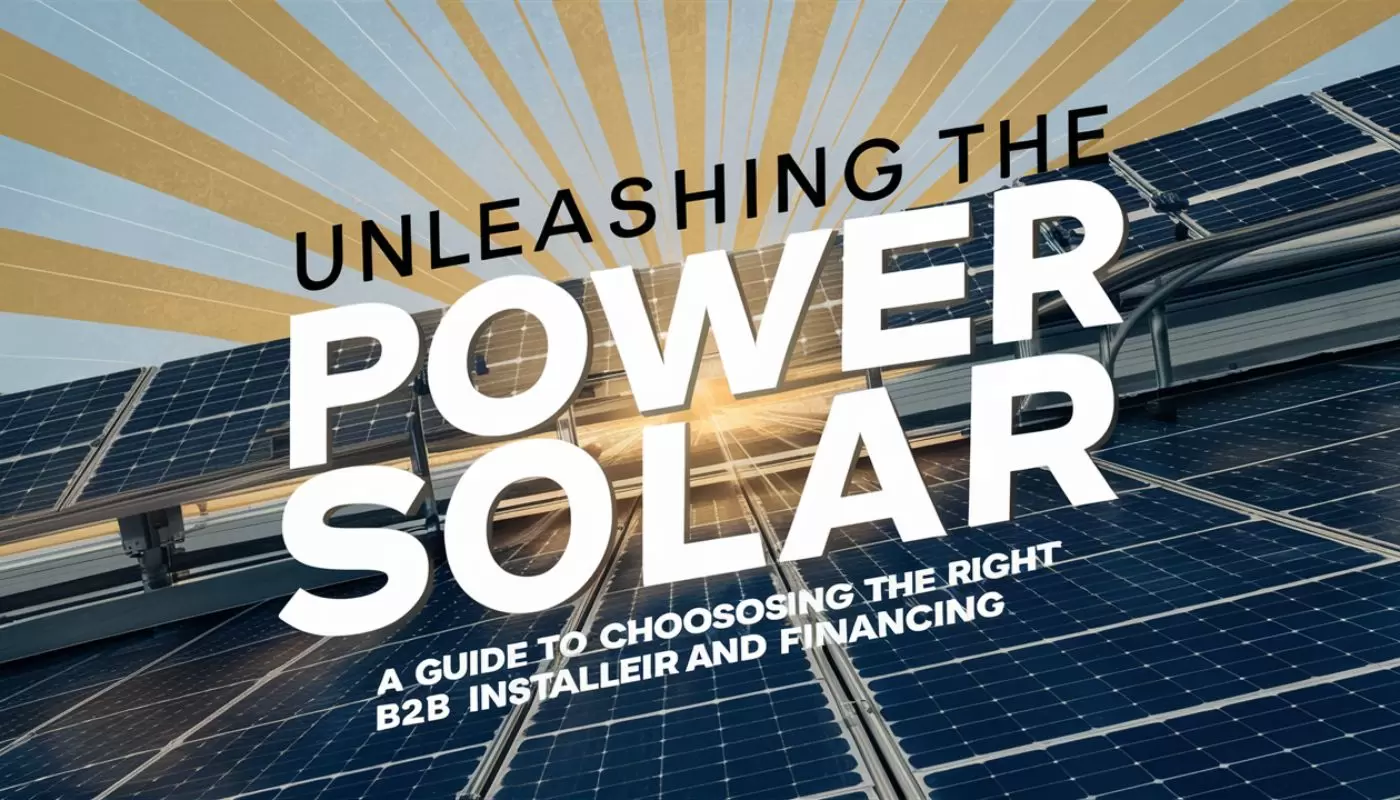Key Factors to Consider When Selecting a B2B Solar Installer
As businesses increasingly embrace sustainability and renewable energy solutions, installing solar panels has become a strategic priority. However, with numerous solar installers in the market, choosing the right one for your company’s energy needs can be a daunting task. Here are some critical factors to consider when evaluating potential installers:
Experience and Track Record: Look for a solar installer with a proven track record of successful installations in the industry. Check their years of experience, the number of projects they have completed, and customer reviews or testimonials. An experienced installer with a solid reputation is more likely to deliver a seamless solar project and provide valuable insights throughout the process.
Certifications and Credentials: Ensure that the installer you choose holds the necessary certifications and credentials required in your state or region. This may include certifications from organizations like the North American Board of Certified Energy Practitioners (NABCEP) or state-specific licenses. Certified installers demonstrate their commitment to quality workmanship and adherence to industry best practices.
Service Area and Availability: Consider installers that operate within your geographical area and have the capacity to take on your project. Local installers may have a better understanding of local building codes, permitting processes, and specific regional challenges, which can streamline the installation process.
System Specialization: Evaluate the installer’s expertise in the type of solar system you require. Some installers may specialize in commercial or industrial-scale projects, while others may focus on residential installations. Ensure their experience aligns with the size, complexity, and unique requirements of your project.
Additional Services: Beyond the initial installation, consider whether the installer offers ongoing maintenance, monitoring, and support services. These services can help ensure optimal energy production and efficiency throughout the lifespan of your solar system, maximizing your investment’s long-term value.
By carefully evaluating these factors, you can increase your chances of finding a reliable and competent solar installer who can guide you through your solar journey successfully.
Evaluating Solar Financing Options for Your Business

While the long-term benefits of adopting solar power are undeniable, the upfront costs of installation can be a significant barrier for many businesses. Fortunately, various financing options are available to make solar investments more accessible and cost-effective. Here’s an overview of common financing routes:
PACE (Property Assessed Clean Energy) Financing: PACE financing allows businesses to fund their solar project through a special assessment on their property tax bill. This option requires no upfront costs, and the repayment obligation transfers to the new owner if the property is sold, making it an attractive choice for businesses that may relocate or sell their facility.
Solar Loans: Traditional loans offer a way to finance your solar installation with fixed interest rates and repayment terms. These loans can be secured or unsecured, depending on your business’s creditworthiness and assets. Solar loans may also qualify for tax incentives and rebates, further reducing the overall cost.
Solar Leases/PPAs (Power Purchase Agreements): With a solar lease or PPA, a third-party investor owns and maintains the solar system, while your business pays a fixed rate for the energy generated. This option eliminates upfront costs and maintenance responsibilities, but you may not be eligible for certain incentives.
Operating Leases: Similar to a traditional lease, an operating lease allows your business to “rent” a solar system for a fixed monthly payment. At the end of the lease term, you can typically purchase the system, renew the lease, or have the system removed.
When evaluating these financing options, consider factors such as your upfront capital, long-term budget, tax appetite, building ownership status, and the anticipated duration of your occupancy. Additionally, carefully analyze the financing rates, terms, and conditions to ensure you select the option that maximizes your potential return on investment (ROI) and aligns with your business’s financial goals.
Tips for Choosing the Ideal Financing Path
- Assess your upfront capital and long-term budget: Determine how much you can afford to invest upfront and what ongoing payments fit within your financial projections.
- Consider your tax appetite and eligibility for incentives: Certain financing options may qualify you for tax credits, rebates, or other incentives that can significantly reduce your overall costs.
- Evaluate your type of building and ownership status: If you own the building, financing options like PACE or solar loans may be more suitable, while leases or PPAs could be better for rented spaces.
- Assess how long you plan to occupy the facility: If you anticipate staying in the same location for an extended period, ownership-based financing may be preferable, as you’ll eventually own the system outright.
- Analyze the financing rates, terms, and conditions carefully: Thoroughly review the fine print, including interest rates, escalation clauses, early termination fees, and any other potential hidden costs.
By carefully weighing these factors, you can select the financing path that best aligns with your business’s unique circumstances and goals, ensuring a smooth and cost-effective transition to solar power.
Read This : WHY RECONCILING YOUR BANK STATEMENTS IS CRUCIAL FOR FINANCIAL HEALTH
Conducting a Thorough Vetting Process

Once you’ve narrowed down your list of potential solar installers, it’s crucial to conduct a thorough vetting process to ensure you’re making the best choice for your business. Here are some key steps to follow:
- Get Multiple Quotes: Obtain detailed quotes from at least three prospective installers. This allows you to compare pricing, warranties, and the scope of services offered. Be wary of quotes that seem significantly lower than others, as this could indicate subpar equipment or workmanship.
- Verify Credentials, Insurance, and Licenses: Ensure that the installers you’re considering have the necessary licenses, certifications, and insurance coverage required in your area. Ask for proof and check with the appropriate regulatory bodies to confirm their validity.
- Inspect Sample Work and Customer Testimonials: Request to see examples of the installer’s previous work and read customer testimonials or reviews. This can give you valuable insights into their quality of work, professionalism, and customer service.
- Assess Responsiveness and Transparency: During the vetting process, take note of how responsive and transparent each installer is in addressing your questions and concerns. A reputable installer should be forthcoming with information and readily available to address any issues that may arise.
- Conduct Site Visits and Interviews: If possible, visit the installer’s office or warehouse to get a sense of their operations and professionalism. Additionally, consider scheduling in-person interviews with key personnel who will be involved in your project to assess their expertise and communication skills.
By taking the time to thoroughly vet your potential installers, you can make an informed decision and increase the likelihood of a successful solar installation that meets your business’s specific needs and expectations.
Read Also This: HOW TO START A BANK: THE ULTIMATE GUIDE
Once you’ve selected your solar installer and secured the necessary financing, it’s time to implement your solar strategy successfully. Here are some key considerations:
Working Closely with Your Chosen Installer: Establish clear lines of communication and regular check-ins with your installer throughout the process. Discuss your project requirements, timeline, and any specific concerns or preferences you may have.
Understanding Permits, Inspections, and Interconnection: Your installer should guide you through the necessary permitting processes, inspections, and interconnection procedures required to connect your solar system to the grid. Familiarize yourself with these steps to ensure a smooth and compliant installation.
Anticipating the Installation Timeline Realistically: While your installer should provide an estimated timeline, be prepared for potential delays due to factors like weather, permitting issues, or supply chain disruptions. Discuss contingency plans and stay informed throughout the installation process.
Procedures for Monitoring and Maintenance: Inquire about the installer’s procedures for monitoring your solar system’s performance and scheduling regular maintenance checks. Proper monitoring and maintenance are crucial for maximizing your system’s energy production and efficiency over time.
Engaging Your Team and Stakeholders: Ensure that all relevant stakeholders within your business, including facilities managers, financial teams, and leadership, are informed and involved throughout the solar project. Their buy-in and support can help ensure a successful implementation and ongoing management of your solar system.
By working closely with your chosen installer, understanding the necessary processes, and engaging your team, you can successfully navigate the installation and optimize the long-term benefits of your solar investment.
Conclusion
Transitioning to solar power is a strategic move for businesses seeking to reduce their environmental impact, achieve long-term cost savings, and demonstrate their commitment to sustainability.












